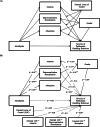Problematic Gambling Behavior in a Sample of Gamblers: The Role of Alexithymia, Dissociation Features, and External Locus of Control
- PMID: 38831237
- PMCID: PMC11557621
- DOI: 10.1007/s10899-024-10322-6
Problematic Gambling Behavior in a Sample of Gamblers: The Role of Alexithymia, Dissociation Features, and External Locus of Control
Abstract
Gambling disorder is a severe condition that significantly compromises the lives of those affected. In light of this clinical relevance, the literature on the antecedents of this form of addiction is constant and continually evolving. Consistently with this framework, the present research aimed at investigating the role of some risk factors in gambling disorder, with a specific focus on alexithymia, dissociation, and locus of control. The research involved a sample of 290 participants (183 males and 107 females; Mage = 34.43, SD = 14.65) who practice gambling at least occasionally. They completed an online survey including the South Oaks Gambling Screen, Twenty-Items Toronto Alexithymia Scale, Dissociative Experience Scale-II, and Locus of Control of Behavior. ANOVA and a moderated-mediation model were implemented to analyse the collected data. Results showed that 19.0% of the participants were At Risk and Problem Gamblers, while 27.6% fell into the category of Problematic Gamblers. Problematic Gamblers showed significantly higher levels of alexithymia, dissociation, and external locus of control. Moreover, a significant association between alexithymia and the severity of problematic gambling behaviour was found and was significantly mediated by absorption (a dissociation feature). Furthermore, the external locus of control significantly moderated this indirect effect. The role of gender as a covariate was also investigated. Such findings may offer further insights into the field of clinical research on gambling disorder and may provide useful information for effective clinical practice.
Keywords: Absorption; Alexithymia; Behavioural addictions; Dissociation; Gambling disorder; Locus of control.
© 2024. The Author(s).
Conflict of interest statement
Figures
Similar articles
-
Alexithymia, Dissociation, and Family Functioning in a Sample of Online Gamblers: A Moderated Mediation Study.Int J Environ Res Public Health. 2021 Dec 16;18(24):13291. doi: 10.3390/ijerph182413291. Int J Environ Res Public Health. 2021. PMID: 34948900 Free PMC article.
-
Alterations in the Emotional Regulation Process in Gambling Addiction: The Role of Anger and Alexithymia.J Gambl Stud. 2017 Jun;33(2):633-647. doi: 10.1007/s10899-016-9636-4. J Gambl Stud. 2017. PMID: 27550365
-
Gambling and Attachment: The Mediating Role of Alexithymia in Adolescents and Young Adults.J Gambl Stud. 2021 Jun;37(2):497-514. doi: 10.1007/s10899-020-09965-y. J Gambl Stud. 2021. PMID: 32728984
-
[To an integrative management of pathological gamblers].Encephale. 2011 Dec;37(6):410-7. doi: 10.1016/j.encep.2011.05.003. Epub 2011 Jul 5. Encephale. 2011. PMID: 22137212 Review. French.
-
Gambling Problems and Alexithymia: A Systematic Review.Brain Sci. 2019 Aug 7;9(8):191. doi: 10.3390/brainsci9080191. Brain Sci. 2019. PMID: 31394857 Free PMC article. Review.
Cited by
-
Hazardous gambling behavior is associated with amplified emotional reactivity to gambling outcomes.J Behav Addict. 2025 Feb 6;14(1):480-489. doi: 10.1556/2006.2025.00003. Print 2025 Mar 28. J Behav Addict. 2025. PMID: 39912852 Free PMC article.
-
The Mediating Effect of Gambling Motives between Psychiatric Symptoms, Dissociation, and Problem Gambling Severity.J Gambl Stud. 2025 Sep;41(3):1229-1245. doi: 10.1007/s10899-025-10408-9. Epub 2025 Jun 27. J Gambl Stud. 2025. PMID: 40576929
References
-
- Abbott, M. W. (2020). The changing epidemiology of gambling disorder and gambling-related harm: Public health implications. Public Health, 184, 41–45. 10.1016/j.puhe.2020.04.003. - PubMed
-
- American Psychiatric Association. (2013). Diagnostic and statistical manual of mental disorders (5th ed.). American Psychiatric Publishing.
-
- American Psychiatric Association. (2022). Diagnostic and statistical manual of mental disorders (5th ed.). text revision; American Psychiatric Publishing.
-
- Bagby, R. M., Parker, J. D., & Taylor, G. J. (1994a). The twenty-item Toronto Alexithymia Scale—I. item selection and cross-validation of the factor structure. Journal of Psychosomatic Research, 38(1), 23–32. 10.1016/0022-3999(94)90005-1. - PubMed
-
- Bagby, R. M., Taylor, G. J., & Parker, J. D. (1994b). The twenty-item Toronto Alexithymia Scale—II. Convergent, discriminant, and concurrent validity. Journal of Psychosomatic Research, 38(1), 33–40. 10.1016/0022-3999(94)90006-X. - PubMed
MeSH terms
LinkOut - more resources
Full Text Sources
Medical



